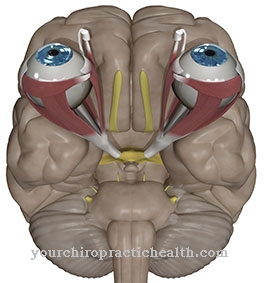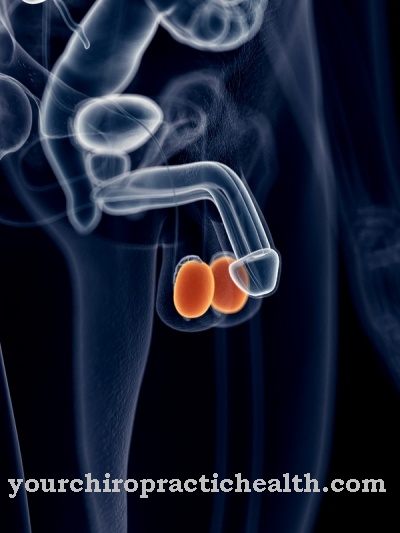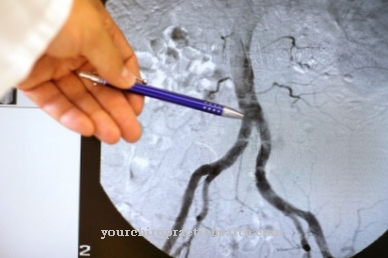A Patellar dysplasia is a malformation that leads to asymmetry of the kneecap and can be both congenital and acquired. Congenital dysplasias of the kneecap are often the symptom of malformation syndrome, while acquired forms are due to accidents. The therapy consists mainly of physiotherapy and the administration of painkillers.
What is patellar dysplasia?

© Axel Kock - stock.adobe.com
The patella is also known as the kneecap. It is a flat, disc-shaped, triangular bone in front of the knee joint. The kneecap is involved in the articular surfaces of the knee joint and takes on the function of a sesamoid bone in the tendon of the adjacent muscle. The main task of the patella is the lacing of the knee joint and the lever arm extension of the quadriceps femoris muscle.
In medicine, dysplasia is the deformity or malformation of tissues or organs. The Patellar dysplasia against this background corresponds to a malformation of the bony kneecap. Non-appendages are not malformations in the strict sense. However, underdevelopment or overdevelopment of the kneecap can certainly be referred to as patellar dysplasia.
The malformation of the kneecap can be the result of a hereditary disease, but it can also be acquired through accidents in the course of life. In the narrower definition there is only talk of patellar dysplasia if the kneecap is asymmetrical.
causes
The causes of patellar dysplasia range from genetic mutations to processes of the patellar tissue after trauma. This enables a distinction to be made between congenital and acquired causes in connection with kneecap dysplasia. The dysplasia of the patella can occur, for example, in the context of various malformation syndromes and is then in most cases due to genetic mutations.
Such mutations can have a hereditary basis and can thus be passed on in an autosomal dominant or autosomal recessive mode of inheritance. If the malformation of the patella occurs as part of a syndrome, it is simply a symptom of a general phenomenon. The dysplasia can also be acquired and thus correspond, for example, to a complication after surgery or injuries to the kneecap. Depending on the cause, the malformation sometimes manifests itself in clinically different symptoms.
Symptoms, ailments & signs
The symptoms of patellar dysplasia are highly dependent on the cause of the deformity. What the dyplasias of the patella have in common in the narrower definition is an asymmetry that causes abrasion of the cartilage layer due to the load. Even in small children, pronounced patellar dysplasia can cause considerable pain.
A subtle malformation of the kneecap can remain asymptomatic for decades and does not cause any symptoms. Most of those affected initially only complain of stress-related pain. Later, the pain can also occur in relaxation situations. A progressive patellar dysplasia is also noticeable in creaking noises during exercise and in bruises on the skin.
How quickly patellar dysplasia progresses and how severe the pain is depends on the cause. Genetically determined dysplasias can be characterized in individual cases, for example, by rapid progression. The level of stress also plays a role in progression.
Diagnosis & course of disease
A dysplasia of the patella can be visualized via X-ray imaging and thus diagnosed without a doubt. Researching the cause is a little more difficult. The anamnesis can give the doctor first indications of past accidents with kneecap injuries or genetic hereditary diseases. A specialist can recognize pronounced dysplasia of the patella with the naked eye.
Nevertheless, X-ray imaging is relevant for diagnosis, as it makes it easier to assess the extent of the dysplasia. In many cases, patellar dysplasia is only diagnosed at an advanced stage, as it does not necessarily have to cause symptoms until then. The typical symptoms of exertion-related pain and crunching noises in the knees prompt the doctor to perform imaging.
The prognosis for patients with patellar dysplasia depends on the cause. By and large, any asymmetry in the patella is largely irreversible. However, accident-related patellar dysplasias are often diagnosed earlier than genetic ones and can thus be blocked more easily.
Complications
Patients experience severe pain primarily due to patellar dysplasia. These occur primarily during stress and movement, so that the patients are severely restricted in their everyday life. This leads to restricted mobility and a general reduction in resilience. The knees are often swollen and covered with bruises.
Even without stress, patellar dysplasia can lead to significant pain, so that many patients also suffer from psychological complaints or depression. Furthermore, the pain of this disease can also appear at night and thus lead to sleep problems or irritability of the person concerned. The quality of life of the patient is thus considerably restricted and reduced. This disease can also occur in children and thus possibly significantly restrict their development.
A causal treatment of patellar dysplasia is not possible. In their lifetime, those affected have to rely on various therapies and on the use of painkillers to alleviate these symptoms. The disease does not reduce life expectancy. However, the disease can limit the patient's life and prevent them from participating in physical activity.
When should you go to the doctor?
If visual abnormalities of the skeletal system in the knee area are observed in a newborn child, a doctor should clarify the existing changes. Normally there is a birth, which is accompanied by obstetricians in the inpatient as well as at home. Immediately after the delivery, the midwives, nurses and doctors present take over the initial examinations of the child.
In these cases, the relatives do not have to take any further steps to investigate the cause of the optical characteristics. If the malformation of the kneecap only shows up in the course of life, action is required. A doctor is required in the case of locomotion disorders, restrictions in the mobility of the knee joint and low physical stress.
Pain, low muscle strength, swelling and disorders of the blood circulation should be examined and treated. If there is a noise in the knee area while moving, this is an alarming sign. A doctor should be visited to prevent further damage. If there are no symptoms despite the recognizable malformation of the kneecap, a check-up visit to a doctor is recommended. The functions of the knee are checked and documented in the affected person. Follow-up visits to a doctor are only necessary in these cases if there are changes in life or symptoms develop.
Therapy & Treatment
The treatment of patellar dysplasia is not possible on a causal basis. Neither genetic causes nor kneecap trauma can be reversed to revise the symptom of asymmetry. Symptomatic treatments are available for patients with kneecap dysplasia. In individual cases, the therapy options depend on the progress of the cartilage damage.
Destroyed cartilage cannot be rebuilt. However, if patellar dysplasia is diagnosed early enough, the progression of cartilage damage may be limited. The focus of the therapy is therefore on measures that contribute to the preservation of the remaining cartilage. For example, the affected knee should be protected from excessive stress.
In this context, physiotherapy can provide the patient with strategies for reducing stress. In physiotherapeutic care, the patient also builds up muscles that are located around the knees and can thus have a dampening and stabilizing effect on the kneecap. Conservative therapy with pain medication can relieve the patient's pain.
In extreme cases, a surgical replacement of the affected patella takes place at a later stage in order to keep the patient able to walk. Physiotherapy is essential even after such an operation.
You can find your medication here
➔ Medicines for joint painOutlook & forecast
The prognosis for patellar dysplasia is to be assessed according to the individual circumstances. However, a cure cannot be assumed. In the case of a congenital disorder, recovery is not possible, as the genetic material of the human being cannot be changed by doctors for legal reasons. The treatment depends on the individual characteristics of the malformation syndrome.
Normally, the development and growth process of the patient is continuously accompanied by physiotherapy. As a result, the person concerned learns at the beginning of his life how to optimally stress the body. Even if a complete cure is not to be expected, there can still be considerable alleviation of existing symptoms. At the same time, it can be achieved that serious secondary disorders are avoided.
Recovery from acquired patellar dysplasia is also unlikely. If the cartilage in the knee area has been damaged or completely destroyed, it cannot be restored. Long-term therapy is also necessary so that a change in physical resilience is learned. The aim of the therapy is to minimize the pain while still optimizing everyday life.
In particularly severe cases, surgery is carried out. This decision is independent of the cause and depends on the existing damage. If the operation goes without any further complications, physiotherapeutic care can then begin.
prevention
Kneecap dysplasia cannot be completely prevented. Some acquired patellar dysplasias are the result of misalignments or poor posture. This type of dysplasia can be prevented by exercising.
Aftercare
In many cases of patella dysplasia, those affected have no special or only limited follow-up measures available. Therefore, the patient should consult a doctor at the first symptoms or signs of the disease so that there are no further complications or other complaints. Since it is a genetic disease, it cannot be completely rushed back.
If you want to have children, genetic testing and counseling is recommended to prevent patellar dysplasia from recurring. Most of those affected are dependent on the measures of physiotherapy or physiotherapy. The person concerned can also do many of the exercises in their own home and thus increase the mobility of the body.
Most of those affected are also dependent on the help and support of their own family in everyday life. It is not uncommon for psychological support to be necessary to avoid depression or other psychological upsets. Regular visits to a doctor are also very useful in order to check the condition of the symptoms. It cannot be universally predicted whether patellar dysplasia will lead to a reduced life expectancy for the person affected.
You can do that yourself
With patellar dysplasia, the knee and the affected leg should not be subjected to heavy loads. Sports activities should be tailored to the needs of the person concerned so that the organism is not damaged further. Together with the doctor or a physiotherapist, exercises and training units can be worked out, which are carried out daily independently and independently. This serves to support an optimal supply of the muscles, tendons and nerve fibers. In addition, the demands of the bones and joints can be promoted in the best possible way.
Carrying and lifting heavy objects should be avoided. Unilateral movements and poor posture are also to be avoided. So that the skeletal system is not subjected to further overexertion, it is important to pay attention to its own weight. Obesity or excessive weight gain have a negative impact on the health of the person concerned. We recommend a body weight according to the guidelines of the BMI.
To cognitively cope with pain or other complaints, the use of relaxation techniques can lead to relief. With methods such as meditation or yoga, inner tension is relieved and at the same time well-being is strengthened. Optimal nutrition is advisable to promote your own health. The nutrients absorbed through fresh food or liquids cause regeneration and strengthen the body's own defense system.

.jpg)











.jpg)

.jpg)
.jpg)











.jpg)